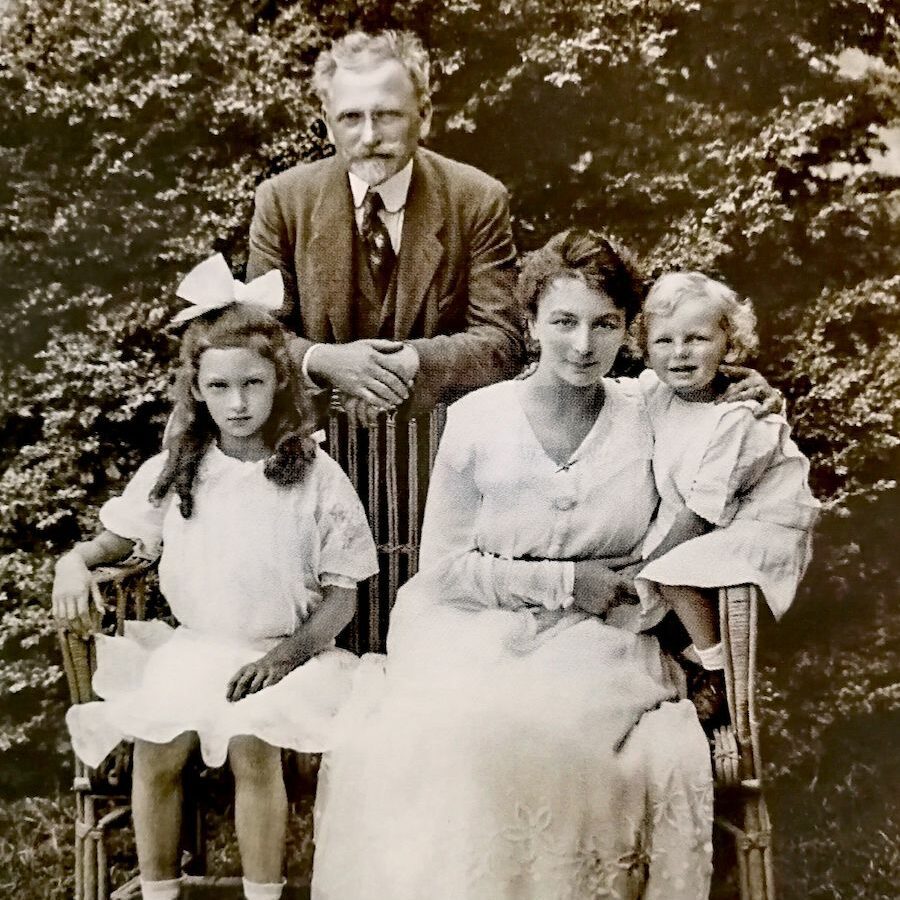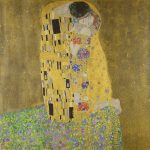
Alphonse Mucha, a name synonymous with Art Nouveau, created works that not only shaped a movement but also touched hearts. His intricate illustrations of women, floral designs, and elegant lines captured a sense of romanticism and beauty that stood out in late 19th-century art. While many are familiar with his artistic accomplishments, few know the captivating love story behind his inspiration: the relationship with his beloved Maruška Chytilová. This story of love, passion, and dedication played an essential role in shaping Mucha’s life and career.
The Meeting: A Chance Encounter in Prague
Alphonse Mucha first crossed paths with Maruška Chytilová in 1903 when she was just 17 years old. Maruška, the daughter of a prominent lawyer in Prague, was a beautiful and intelligent young woman who harbored a deep passion for the arts. At 43 years old, Mucha was already an established artist, well-known for his work in Paris, particularly for his posters of the famous actress Sarah Bernhardt. Mucha had returned to his homeland, and it was during this period that the two met at a gathering of artists and intellectuals.
Their initial interaction was marked by a shared love for the arts and culture. Maruška admired Mucha’s work and, as a talented artist herself, was drawn to his insights into the world of Art Nouveau. Mucha, in turn, was captivated by Maruška’s youthful energy and artistic aspirations. What started as a mentor-student relationship soon blossomed into something deeper.
A Growing Connection: Love and Collaboration
Despite their significant age difference, the relationship between Mucha and Maruška quickly grew into a deep and loving partnership. Maruška became much more than just a muse to Mucha; she was his confidante and collaborator. The two shared many artistic ideas and often worked together on various projects. Maruška was an aspiring painter and sculptor, and Mucha, ever the supportive partner, encouraged her in every way possible.
Mucha’s admiration for Maruška’s intellect and beauty is evident in many of his works during this time. He often depicted her in his paintings and illustrations, using her as a model for some of his most iconic pieces. Maruška’s ethereal beauty, combined with Mucha’s distinctive style, created works that are still celebrated today for their timeless elegance.
As Mucha’s work evolved, so too did his relationship with Maruška. The couple spent countless hours together in Mucha’s studio, discussing art, life, and their dreams for the future. This period of intense collaboration and creative energy culminated in the creation of Mucha’s magnum opus, “The Slav Epic,” a series of monumental paintings depicting the history and mythology of the Slavic people.
Marriage and Family: A New Chapter
In 1906, after three years of courtship, Alphonse Mucha and Maruška Chytilová married in Prague. Their wedding was a modest affair, attended by close family and friends. The couple moved to America shortly after their marriage, as Mucha had been offered a teaching position at the Art Institute of Chicago. Although Mucha had achieved great success in Europe, he sought new opportunities in the United States, and Maruška, ever the supportive wife, followed him on this new adventure.
Their time in America was marked by both personal and professional growth. Maruška gave birth to two children: a son, Jiří, and a daughter, Jaroslava. Mucha continued to work on his artistic projects, while Maruška took on the role of a mother, balancing her own artistic pursuits with her family responsibilities.
Despite the challenges of raising a family in a foreign country, the bond between Mucha and Maruška remained strong. Mucha often credited his wife for being his anchor during this time, providing him with the love and support he needed to continue his work. In turn, Maruška found inspiration in her husband’s dedication to his craft, and the two continued to collaborate on artistic endeavors.
The Influence of Maruška on Mucha’s Work
Alphonse Mucha’s art is often characterized by the ethereal and idealized depictions of women. Maruška played a significant role in this aspect of his work, serving as both a muse and a direct influence. Her presence can be felt in many of Mucha’s most famous pieces, where the central female figures exude grace, intelligence, and beauty.
It’s impossible to ignore the impact Maruška had on the famous “Mucha Woman”—the archetype of femininity that Alphonse Mucha is best known for. Her striking features, combined with Mucha’s intricate, flowing lines, created a new standard for the depiction of women in art. The women in Mucha’s work are not just objects of beauty; they embody strength, wisdom, and elegance—qualities that Maruška possessed in abundance.
Mucha’s depictions of women moved beyond the sensual and superficial, imbuing his female subjects with a sense of mysticism and depth. Mucha once remarked, “The most important thing is that a work of art should evoke emotion. It must stir the soul.” His art, inspired in large part by his relationship with Maruška, undoubtedly stirs the soul, offering viewers a glimpse into the profound connection between artist and muse.
The Slav Epic: A Testament to Their Love
One of Alphonse Mucha’s greatest achievements, “The Slav Epic,” is a series of 20 monumental paintings that depict the history of the Slavic people. Created between 1910 and 1928, this grand project consumed much of Mucha’s later career, and Maruška was by his side throughout the entire process.
“The Slav Epic” was not only a labor of love for Mucha, but it also reflected his deep connection to his homeland and his passion for Slavic culture. Maruška, who shared Mucha’s love for their native culture, was a constant source of support during the many years it took to complete the project. Mucha’s dedication to the work was unrelenting, and Maruška’s unwavering faith in her husband’s vision provided him with the strength to see the project through to completion.
As Mucha toiled away on “The Slav Epic,” Maruška managed their home and supported her husband emotionally and creatively. Her influence can be seen in the meticulous attention to detail in Mucha’s work, as well as the deeply personal and emotional nature of the paintings. The epic series stands as a testament to Mucha’s artistic genius, but it also speaks to the deep and abiding love that he shared with Maruška.
The Twilight Years: A Love That Endured
As Mucha’s health began to decline in the 1930s, Maruška continued to care for him with the same devotion she had shown throughout their marriage. Despite his failing health, Mucha remained determined to complete his artistic projects, and Maruška was always by his side, providing him with the encouragement he needed.
Tragically, the rise of National Socialist Germany cast a shadow over their later years. In 1939, Mucha was arrested by the Gestapo due to his prominence as a symbol of Czech nationalism. Although he was eventually released, the ordeal took a toll on his already fragile health. Just a few months later, Alphonse Mucha passed away on July 14, 1939.
Maruška was devastated by the loss of her beloved husband, but she remained dedicated to preserving his legacy. She worked tirelessly to ensure that Mucha’s art, particularly “The Slav Epic,” would be remembered and celebrated for generations to come. Maruška’s love for Mucha endured even after his death, and her efforts to honor his memory were instrumental in securing his place in the history of art.
Legacy of Love and Art
The love story of Alphonse Mucha and Maruška Chytilová is one of the most beautiful and inspiring tales in the history of art. Their relationship, built on mutual admiration, artistic collaboration, and deep emotional connection, not only shaped Mucha’s work but also left an indelible mark on the world of art.
Maruška’s influence on Mucha’s work is evident in the grace, beauty, and emotional depth of his female subjects. Their shared passion for art and culture created a bond that transcended the challenges of age, geography, and time. Mucha’s art continues to inspire and captivate audiences around the world, and the love story behind that art only deepens its impact.
As Mucha once said, “Art exists only to communicate a spiritual message.” In many ways, the spiritual message of Mucha’s work is one of love—love for his homeland, love for his craft, and above all, love for the woman who inspired and supported him throughout his life.
A Lasting Inspiration
Today, the works of Alphonse Mucha are celebrated worldwide, not only for their artistic merit but also for the profound personal story that lies behind them. The love between Mucha and Maruška serves as a reminder of the power of partnership, both in life and in art. Their relationship, built on mutual respect and shared passion, was a source of strength for both of them.
Through the years, Maruška’s influence on Mucha’s work has become more widely recognized. Art historians and enthusiasts now appreciate the significant role she played in shaping the artist’s creative vision. The timeless elegance and emotion in Mucha’s work, much of it inspired by Maruška, continue to resonate with audiences, ensuring that their love story remains as enduring as the art they created together.




